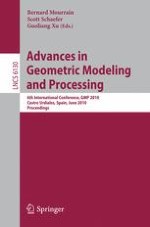2010 | OriginalPaper | Buchkapitel
Decomposing Scanned Assembly Meshes Based on Periodicity Recognition and Its Application to Kinematic Simulation Modeling
verfasst von : Tomohiro Mizoguchi, Satoshi Kanai
Erschienen in: Advances in Geometric Modeling and Processing
Verlag: Springer Berlin Heidelberg
Aktivieren Sie unsere intelligente Suche, um passende Fachinhalte oder Patente zu finden.
Wählen Sie Textabschnitte aus um mit Künstlicher Intelligenz passenden Patente zu finden. powered by
Markieren Sie Textabschnitte, um KI-gestützt weitere passende Inhalte zu finden. powered by
Along with the rapid growth of industrial X-ray CT scanning systems, it is now possible to non-destructively acquire the entire meshes of assemblies consisting of a set of parts. For the advanced inspections of the assemblies, such as estimation of their assembling errors or examinations of their behaviors in the motions, based on their CT scanned meshes, it is necessary to accurately decompose the mesh and to extract a set of partial meshes each of which correspond to a part. Moreover it is required to create models which can be used for the real-product based simulations. In this paper, we focus on CT scanned meshes of gear assemblies as examples and propose beneficial methods for establishing such advance inspections of the assemblies. We first propose a method that accurately decomposes the mesh into partial meshes each of which corresponds to a gear based on periodicity recognitions. The key idea is first to accurately recognize the periodicity of each gear and then to extract the partial meshes as sets of topologically connected mesh elements where periodicities are valid. Our method can robustly and accurately recognize periodicities from noisy scanned meshes. In contrast to previous methods, our method can deal with single-material CT scanned meshes and can estimate the correct boundaries of neighboring parts with no previous knowledge. Moreover it can efficiently extract the partial meshes from large scanned meshes containing about one million triangles in a few minutes. We also propose a method for creating simulation models which can be used for a gear teeth contact evaluation using extracted partial meshes and their periodicities. Such an evaluation of teeth contacts is one of the most important functions in kinematic simulations of gear assemblies for predicting the power transmission efficiency, noise and vibration. We demonstrate the effectiveness of our method on a variety of artificial and CT scanned meshes.
